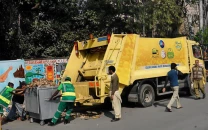Terrorism isn’t Pakistan’s gravest nuclear danger
It is not hard to imagine how accidents, misperceptions, miscalculations could all trigger a South Asian nuclear war.

The writer is director of Non-Proliferation and Disarmament at the International Institute for Strategic Studies and author of Overcoming Pakistan’s Nuclear Dangers
It is true that Pakistan has experienced no nuclear thefts or seizures and no major nuclear accidents. It should also be noted that Pakistan understands the problems of nuclear terrorism and has taken steps to keep its nuclear assets protected. No country devotes more attention to nuclear security.
In a wider sense, however, Pakistan presents several nuclear dangers. The greatest is the potential for a nuclear war sparked by Pakistan-based extremists conducting another spectacular terrorist attack in India like the one in Mumbai in 2008 and the attack on the Indian Parliament in 2001.
The mood in New Delhi, and not just within the BJP camp, is that next time there is an attack which is seen to have Pakistani state fingerprints, India cannot again turn the other cheek. Over the past decade, for example, the Indian Army has promoted a ‘Cold Start’ doctrine of reprisal via incursion by several battle groups across the border.
In response, Pakistan has developed short-range, battlefield use nuclear weapons and asserted that they will be used against attacking conventional forces. The fact that India’s civilian leadership has never endorsed Cold Start makes it no less threatening in Pakistani eyes.
The development of what might be called tactical nukes, launched by 60 kilometres range Nasr missiles, lowers the threshold for nuclear use. This has caused serious alarm among outside observers. So, too, India’s vow that it will employ massive retaliation in response to a nuclear attack, even if against Indian forces operating outside national borders.
With nuclear arsenals numbering not too much more than 100 and systems on a low level of alert status, the strategic arms race in South Asia pales in comparison to the nuclear excesses of the Cold War superpowers. But the introduction of battlefield-use nuclear weapons adds a destabilising element.
Due to the ‘use them or lose them’ choice that could face local commanders, deployment of these systems can lead to rapid escalation if deterrence fails. Pakistan’s need to portray credibility about firing first could sacrifice central government control over strategic weapons in a crisis situation. Pre-delegation can lead to unauthorised use.
These are some of the reasons that Nato moved away from tactical nuclear weapons, which were found to be a costly encumbrance with little practical value. Pakistan insists that its short-range systems will not be pre-deployed, nor will use be delegated to field commanders. In the fog of a crisis, however, even the most robust of command-and-control systems cannot preclude human error.
It is not hard to imagine how accidents, misperceptions and miscalculations could all trigger a South Asian nuclear war. The development of cruise missiles, sea-based platforms and other ambiguous dual-use systems heightens the potential for misperception.
The underdeveloped mechanisms for crisis resolution in South Asia and the absence of dialogue on the factors behind nuclear risks are further reasons for concern. India and Pakistan need to engage each other on the issues that could spark a nuclear clash. Deterrence stability and the factors that contribute to growing nuclear risks should be central topics of dialogue, covering both conventional and nuclear forces.
It is also time to offer Pakistan a path to nuclear normalisation, so that it has an incentive to stop blocking negotiations on a Fissile Material Cut-off Treaty, stop producing plutonium and highly enriched uranium and sign the Comprehensive Test Ban Treaty. Addressing Pakistan’s sense of unfair treatment will enhance prospects for rethinking its tactical nuclear weapons path. Offering nuclear legitimacy is also the most effective way to communicate that the United States and its allies do not seek to forcefully or stealthily disarm Pakistan, and that the Western goal, rather, is deterrence stability.
Holding out the prospect of a nuclear cooperation deal akin to the one accorded India, albeit with stronger non-proliferation conditions, is the most powerful tool Western nations can use to positively shape Pakistan’s nuclear posture.
Published in The Express Tribune, May 7th, 2014.
Like Opinion & Editorial on Facebook, follow @ETOpEd on Twitter to receive all updates on all our daily pieces.














COMMENTS
Comments are moderated and generally will be posted if they are on-topic and not abusive.
For more information, please see our Comments FAQ